| Londinium Calling
Before taking up my duties at this year’s Chianti Crime Fest, I journeyed up to dear old London town for a double event of business and pleasure. To be perfectly honest, it was pleasure and pleasure as both events I attended were jolly, celebratory affairs, both involving newly published books.

At a select dinner given in honour of Lindsey Davis, the undisputed Queen (or should that be ‘Empress’?) of the mystery story set in Ancient Rome, it was not so much a question of celebrating her new book, The Graveyard of the Hesperides (from Hodder) which stars her feisty heroine Flavia Alba, good enough reason though that be, but the fact that it was her thirtieth book with the same editor; surely something of a record these days. As it was a birthday (of sorts), there were, of course, presents – for author, editor and agent – all on a suitably Roman theme and the event was held, fittingly enough, in the famous Soho restaurant Quo Vadis.
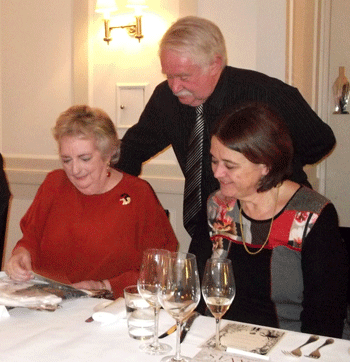
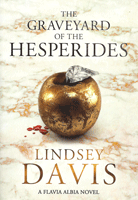
I was able to snatch only a few minutes of conversation with Peter Hannington at the launch of his debut thriller A Dying Breed, published by the Two Roads imprint. As a producer on the BBC’s flagship Today programme, it is not surprising that the plot of A Dying Breed centres on how various elements of the BBC – old school reporters, middle management and “Human Resources” (in other words, the usual suspects) – deal with a fermenting story from Afghanistan following an explosive assassination in Kabul.
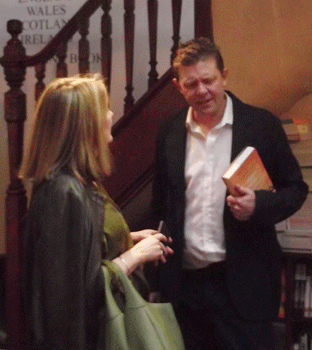
When a fresh-faced young producer, so new he has hardly had time to fiddle his expenses, is sent out to help the grizzled (but efficient) old hack William Carver and is in short order kidnapped, bigger wheels start to turn, not just in the BBC but in the diplomatic corps and the intelligence services. With so many conflicting interests and the stakes rising, a shoot-out on the dusty roads of the Afghan badlands seems inevitable, although the outcome is anything but.
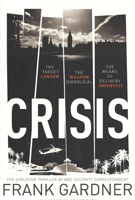 I have to admit that on more than one occasion whilst reading A Dying Breed I feared for those BBC hacks (some of them really rather unsavoury) clearly out of their depth when dealing with terrorists, opium war lords, treacherous spooks and mercenary military types, and the thought did occur to me: why on Earth didn’t they call the BBC’s incredibly brave and distinguished security correspondent Frank Gardner? I have to admit that on more than one occasion whilst reading A Dying Breed I feared for those BBC hacks (some of them really rather unsavoury) clearly out of their depth when dealing with terrorists, opium war lords, treacherous spooks and mercenary military types, and the thought did occur to me: why on Earth didn’t they call the BBC’s incredibly brave and distinguished security correspondent Frank Gardner?
The reason soon became obvious. Not only does Frank Gardner have a very busy job (sadly) these days, but he has been filling what little spare time he has writing a debut thriller of his own.
Crisis, to be published in June by Bantam, begins dramatically in Colombia – twice actually – and it isn’t long before a dastardly plot involving the local drugs cartels begins to unfold. Gardner’s hero who has to uncover and foil the plot, though, is no crusty BBC journalist, but a former Special Boat Section commando hired on a short-term contract by MI6. I suspect that such a resourceful hero, should he survive, may well find himself offered tenure, a development which will be welcomed by Gardner’s publisher.
London’s Burning
Whilst in the capital, I could think of no better place to spend a few contemplative hours reading Andrew Taylor’s new historical mystery Ashes of London than The Old Bell on Fleet Street a hostelry supposedly built by Christopher Wren in 1670 to house his workforce of stonemasons and carpenters employed to rebuild St Bride’s church, destroyed in the Great Fire of 1666.
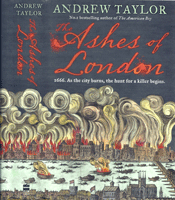
I have to say the publishers HarperCollins have made a splendid job of Andrew’s new book, which opens as the fire rages and consumes St Paul’s cathedral and the horrified crowds look on – coincidentally standing not far from the site of The Old Bell. I mention The Old Bell (again) as it began life, I believe, as a printer’s shop – hardly surprising in Fleet Street – and printing, writing and drawing all form significant elements in the story, which actually features Christopher Wren and his vision for a rebuilt London rising from the ashes.
Some historical mysteries try to shoe-horn in too much history, at the expense of character, plot and often pace. Andrew Taylor displays the vast amount of research he must have done lightly and it never intrudes as he spins his story with clarity and delicacy, using two points of view – the mysterious Cat, a young woman avoiding her family and trying to disguise the fact that she is bright and educated, and James Marwood, the son of a disgraced pamphleteer (now suffering from what we would call dementia) working reluctantly as a government informer. From different angles this pair of very sympathetic characters converge on a mystery which involves the discovery of bodies in the ruins of the burned city, but they are bodies which have not died by accident nor in the fire. And the broader historical perspective, which adds to the tension and sense of paranoia, includes memories of the recent civil war and scores still to be settled; the Restoration of the monarchy, bitterly unpopular in some quarters; running sores left by religious division; the Great Plague and, of course, the Great Fire.
In The Ashes of London Andrew Taylor weaves his way through all this seamlessly. In fact he makes it look easy. He has already won so many crime-writing Daggers for historical mysteries that I hear the props department of Game of Thrones have been in touch. I wouldn’t rule out another one to add to his collection.
(Not) Missing Link
In the history of the detective novel, there are a handful of 19th-century authors who really do deserve the title Founding Father. There can be few mystery readers who are unaware of Edgar Allen Poe or Arthur Conan Doyle, and hopefully few who are unaware of Wilkie Collins sandwiched roughly between them.
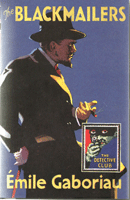 One name which might be unfamiliar, but really shouldn’t be, is that of Émile Gaboriau (1833-73), a true pioneer of the genre and widely regarded as France’s greatest writer of detective stories with the creation of his archetypal detective Monsieur Lecoq. One name which might be unfamiliar, but really shouldn’t be, is that of Émile Gaboriau (1833-73), a true pioneer of the genre and widely regarded as France’s greatest writer of detective stories with the creation of his archetypal detective Monsieur Lecoq.
Writing roughly at the same time as Wilkie Collins in England, Gaboriau’s novels were translated, rather cumbersomely, into English soon after his death in 1873. His Le Dossier No.113, first published in 1867, got a new translation in 1907 as The Blackmailers and was issued under that title by Collins’ famous Detective Story Club brand in 1929. That edition has now been reissued as part of the ongoing programme of making classic crime books available at very reasonable prices, under the revived Collins Crime Club imprint.
A Fury of Festivals
No sooner do I return from this year’s Chianti Crime Festival in Italy, than I exchange Ryanair for Virgin Trains and head west to Bristol and the 2016 CrimeFest.

A month before the festivities commence, some 450 delegates including 150 authors had already registered for the 60 or more events planned and some day pass tickets had sold out. The international roll-call of authors attending includes Ian Rankin, Anne Holt, Peter James, Felix Francis, Michael Ridpath and Ann Cleeves, with debut crime writer Hugh Fraser (better known as Captain Hastings from television’s Poirot) acting as toastmaster at the festival’s awards dinner.
No Noose is Good Noose
One rarely sees a hangman’s noose, or ‘hangman’s knot’, on the cover of a crime novel these days. No doubt there were those who bemoaned the abolition of the death penalty for murder (I believe it still exists for other crimes such as treason, not buying one’s round or masquerading as a sock puppet on Amazon) in 1965 as it would lead to ‘the end of the murder mystery as we know it’. The same moaners later complained that the fall of the Berlin Wall would see the end of the spy novel. Only a fool would have put money on such assumptions – though in my defence, the odds on offer were very attractive…
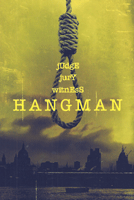 And now not one, but two, novels appear using the noose motif. To be fair, I think it only features on the bound proof of Tony Parson’s new novel The Hanging Club, published by Century this month, rather than the finished book, but it does so to good effect, to promote this contemporary thriller featuring Parson’s series policeman hero, Max Wolfe. In The Hanging Club, Wolfe is up against a gang of vigilantes who have decided to bring back the death penalty – very publicly and with the eager co-operation of ‘social media’. And now not one, but two, novels appear using the noose motif. To be fair, I think it only features on the bound proof of Tony Parson’s new novel The Hanging Club, published by Century this month, rather than the finished book, but it does so to good effect, to promote this contemporary thriller featuring Parson’s series policeman hero, Max Wolfe. In The Hanging Club, Wolfe is up against a gang of vigilantes who have decided to bring back the death penalty – very publicly and with the eager co-operation of ‘social media’.
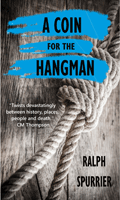 The death penalty, hanging and public hangmen are central to the long-awaited first novel of book dealer Ralph Spurrier and it is no surprise that A Coin for the Hangman [Hookline Books] begins as the story of a book dealer uncovering a story centred on a book, in this case the diary of a man hanged in 1953. The death penalty, hanging and public hangmen are central to the long-awaited first novel of book dealer Ralph Spurrier and it is no surprise that A Coin for the Hangman [Hookline Books] begins as the story of a book dealer uncovering a story centred on a book, in this case the diary of a man hanged in 1953.
Antiquarian book dealers have featured in detective stories before of course, most famously in John Blackburn’s Blue Octavo and George Sims’ The Terrible Door, both Blackburn and Sims having been dealers (in books, that is), but here we have one who specializes in crime fiction. There are lots of references to make sure you don’t forget this, from name-checks of Agatha Christie to a lovely sly reference to Wandsworth Prison being full of ‘little grey cells’. There is also a reference to Freeman Wills Crofts’ 1946 mystery Death of a Train (surely one of the most unexciting thrillers ever written) which signposts the importance in the solution to A Coin for the Hangman of train timetables in the days before Virgin Trains when such things could be relied on to provide an alibi.
There are plenty of references to the so-called ‘Golden Age’ of the English detective story especially when it comes to trains, which devotees of ‘GA detection’ will appreciate and they will certainly spot more than I did. Whether they will be as satisfied with the (deliberately) disjointed flashback techniques in the narration – from 2006 to 1953 to 1939 to 1945 to 1946 – or the inclusion of the gloriously shady, albeit underused character of the prison chaplain, the Rev. Ripley, I am not sure.
One curiosity of the book, which I have never seen before, is in the formatting where words are meant to show emphasis, they are underlined rather than the accepted method of putting them in italics. Is this a new trend or another Golden Age reference which has completely passed me by?
One thing is certain; A Coin for the Hangman may well put you off marshmallows for life!
Triple Hit
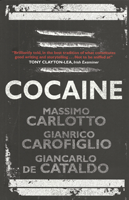 You get three for the price of one in the new anthology Cocaine out this week from the innovative MacLehose Press. Three Italian crime writers that is, each writing a long short story with cocaine at the heart of the plot, though the underling themes include addiction in all its forms, corruption (official and personal) and revenge – always popular when organized crime in Italy is mentioned. You get three for the price of one in the new anthology Cocaine out this week from the innovative MacLehose Press. Three Italian crime writers that is, each writing a long short story with cocaine at the heart of the plot, though the underling themes include addiction in all its forms, corruption (official and personal) and revenge – always popular when organized crime in Italy is mentioned.
The three writers on show – all prominent exponents of Italian crime fiction – are Massimo Carlotto with the story The Campagna Trail, Gianrico Carofiglio with The Speed of the Angel and Giancario de Cataldo with The White Powder Dance. Interestingly, all three authors have considerable experience of the law, though not necessarily a happy experience. Carofiglio is a former anti-Mafia judge in Bari in Puglia whilst De Cataldo is a judge in Rome and visiting professor of law at Birkbeck College, London. Massimo Carlotto was, at the age of 19, falsely imprisoned on a charge of murder and acquitted with a Presidential Pardon only after eighteen years.
Sadly, I was unable to attend the Italian Cultural Institute in London where Gianrico Carofiglio was speaking recently on his latest novel, A Fine Line, to be published in English by Bitter Lemon Press. Only one thing kept me away from the Italian Cultural Institute; I was in Italy.
|
|
Crown Jewels
When Vaseem Khan’s debut novel was published last year, lucky reviewers received a promotional bar of Cadbury’s Dairy Milk chocolate – that particular sweetmeat being crucial to the plot of The Unexpected Inheritance of Inspector Chopra. (A baby elephant is also crucial to the plot, but much more difficult to fit in a jiffy bag.) Vaseem’s charming book had the misfortune to arrive at exactly the same moment as a review copy of the latest Deon Meyer thriller, to which was attached a small bottle of fine South African wine (crucial to the plot, you understand).
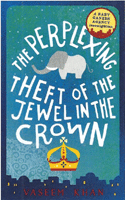
I have to admit that Vaseem’s book was not the first of those two review copies I turned to, but I enjoyed it very much and was looking forward to his next, The Perplexing Theft of the Jewel in the Crown, another Inspector Chopra mystery to be published by Mulholland. Unfortunately, the Hindu god Ganesh must have been looking the other way as my review copy of Vaseem’s new novel arrived (without chocolate) at exactly the same time as my review copy of Abir Mukherjee’s debut crime novel A Rising Man set in 1919 Calcutta, published this month by Harvill Secker. Interestingly, and I am sure it is absolutely essential to the plot, A Rising Man came with a small (I emphasise small – hardly a tooth-full) bottle of Bombay Sapphire gin. Once again, I had to make difficult decisions on which book to tackle first…
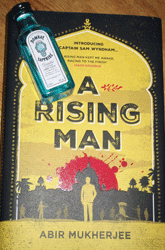
A Rising Man features Captain Sam Wyndham, formerly of Scotland Yard and military service in World war I, newly arrived in Calcutta to head up the police’s new CID branch. It is not a good time given the anti-Raj feeling growing in India, especially not when, straight off the boat, Captain Wyndham has to dive immediately into a murder investigation. I suspect he might have need of a few stiff gins.
I have it on the excellent authority of that Young Turk of crime reviewers, Jake Kerridge, that not only is A Rising Man a jolly good book, but that Abir Mukherjee could be a rising man in the world of British crime fiction.
For his new Inspector Chopra mystery, Vaseem Khan has relied on a famous Indian legend and a time-honoured crime fiction plot structure: the theft of the Koh-i-Noor diamond no less in what is sure to become a classic example of the elephant-in-the-locked-room-mystery.
D(etective) Litt.
A few years ago, Dror Mishani, who is described as ‘a literary scholar specialising in detective literature’ (as, of course, is Professor Barry Forshaw; I hear that makes two of them), asked the question: why are there no detective novels in Hebrew? It was already a rhetorical question as, under the name D. A. Mishani, he had embarked on writing some.

Now the third of Mishani’s police procedurals featuring Israeli cop Inspector Avraham Avraham, The Man Who Wanted to Know, appears in English, published in June by Riverrun – which turns out to be a new imprint of Quercus books ‘dedicated to upmarket crime’ and not the ancestral home of House Tully in Game of Thrones as I had automatically assumed.
Off the Shelf
It is entirely due to the new prescription lenses I have had fitted into the pince-nez I have to wear these days when working in the libraries at Ripster Hall, that I was drawn to the cover illustration of a vintage paperback.
The book in question was the 1934 novel Tender Is the Night by F. Scott Fitzgerald in its 1958 Penguin edition and what caught my eye – something I had not noticed in the four decades I have possessed the book – was that the cover design had been signed by the artist and that the artist in question was my old pal Len Deighton.
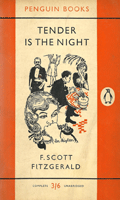 
I was well aware that before he turned to the Dark Side and began writing excellent thrillers, Len pursued a successful career as a graphic artist and illustrator, but I had no idea that I owned an example of his work in those pre-Ipcress File days, and for the record I proudly admit to having read The Ipcress File more recently and many more times than Tender Is The Night, if indeed I read it at all.
Nouveau Noir?
One of the most unusual, not so say fairly impractical, promotional gifts to accompany the advance proof of a new novel must surely be the bag of dried rose petals which came with Blood Wedding by French author Pierre Lemaitre, to be published here by MacLehose in July.
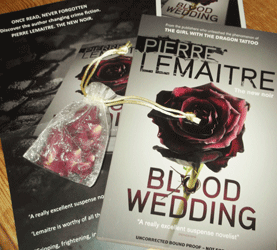
The book comes with advance praise from Stephen King, Marcel Berlins and Barry Forshaw, and as I value two of those opinions quite highly, I am certainly looking forward to it. Even on a cursory glance, the small withered bouquet seems to be a perfectly logical promotional tool for Blood Wedding and I could not but be reminded of the tragedy of my near neighbour Amelia Havisham some years ago. The advance publicity makes much of this being an example of ‘the new noir’ and I am naturally keen to learn exactly what is meant by that. From my all-too-brief perusal, my initial impression is that Blood Wedding is reminiscent of Cornell Woolrich at his darkest, but updated to take account of modern technology and, of course, in French. Now in my book, that would be Old School Noir of the highest order, which Pierre Lemaitre should take as a compliment.
McDoctorates
I was delighted to hear that the University of Glasgow has awarded an honorary doctorate on the legendary William McIlvanney, who was generally regarded, and quite rightly, as the Godfather of ‘Tartan Noir’. Sadly, the honour comes four months after McIlvanney’s death in December last year, at the age of 79, although I understand he was informed by his old university that the award would come this year.
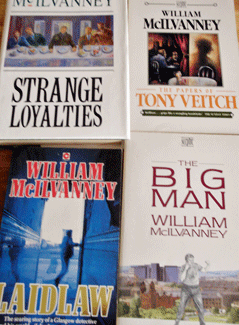
As a fledgling crime writer I was advised (nay, ordered) to read Laidlaw, McIlvanney’s most famous crime novel by his fellow Scot George Thaw, then the literary editor of the Daily Mirror. The instruction came with the brief that if I wanted to see a master at work, I should read McIlvanney and for once, advice from a Fleet Street journalist was not only accurate but gratefully received.
I was, shortly after, encouraged by another Scot, Val McDermid, to snap up other novels by McIlvanney of which I had been unaware and, as always, I do what Val tells me. (Though I think she was secretly impressed that I had already devoured Laidlaw.)
It is a great pity that McIlvanney will not be there to collect his doctorate in person. Fate has not been kind recently to worthy Scotsmen (I am thinking of ‘Sir’ Ronnie Corbett) who have died before they received the honours they were due.
Go East, Old Man
I first came across the name Seicho Matsumoto (1909-1992) in The Oxford Book of Detective Stories published in 2000 and edited by reviewer and anthologist Patricia Craig and I remember telling Pat how deeply impressed I was with her knowledge of international crime fiction and the gratitude I felt for her bringing previously unknown crime writing to my attention. Interestingly, on consulting the anthology 16 years on, I discover that of the 37 authors featured, only one hailed from Scandinavia – the Finn Pentti Kirstilä – which might indicate that Pat was ahead, or behind, the curve when it came to ‘Nordic Noir’.

At the time I promised myself that I would read more of Matsumoto’s crime fiction as I discovered he had been a prolific author (usually known in the west as the ‘Japanese Simenon’), a keen archaeologist and a leading light in the Japanese equivalent of the Crime Writers Association. Of course, as with so many promises of youth, I never did make the effort to do so. However I now have no excuse as, next month, Bitter Lemon Press are publishing A Quiet Place, one of Matsumoto’s 1975 crime thrillers, in, I think, its first English translation.
By the great beard of Zeus!
I may be misquoting that famous documentary film Anchorman but I feel some expletive of delight is necessary to welcome, however tenuously, two new titles this month from publisher Head of Zeus which epitomise the width of the wonderfully broad church that is crime/thriller/mystery fiction.
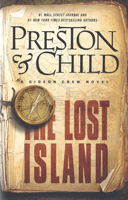 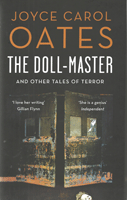
At one end of the spectrum is a rip-roaring adventure thriller featuring treasure maps, an ancient legend or two (‘follow the Devil’s vomit’!) and a ‘missing’ island, something which has featured in the past in excellent romps by Peter Benchley and Geoffrey Jenkins, but now gets a thoroughly modern make over in The Lost Island by those acknowledged masters of the adventure thriller, the American writing team of Douglas Preston and Lincoln Child.
At the other end of the scale, with the emphasis on suspense and an icy appreciation of how to put terror down on paper, the multi-award winning Joyce Carol Oates shows how it should be done in The Doll-Master, her impressive new collection of fairly long short stories.
October Fest
Last year I reported on the formation of the London-based ‘collective’ (if that is the correct word) of female crime writers Killer Women, which I am told must on no account be confused with the ill-fated American television show which was cancelled after eight episodes in 2014.
 
Unlike their Hollywood counterparts,the real Killer Women are going to be busy this year, having lined up a whole series of events at conventions and festivals, starting with CrimeFest in Bristol this month and with a dedicated Killer Women Festival in London in October.
Before then there will be a strong KW presence at the Slaughter in Southwold crime writing festival in June, organised by Suffolk Libraries. In the recent KW Newsletter, Southwold is described as “a charming seaside town” but in truth it is famous not for being charming (which it is), nor for being near the sea (which is geographically indisputable), but for being the home of the mighty Adnams brewery, the secret source of East Anglia’s power and influence since 1872.

I am sure that Slaughter in Southwold will be a much-used phrase, one way or another, in mid-June as the festival takes place in the same week as the first national Beer Day which will surely draw a large and appreciative audience to the area.
Pip! Pip!
The Ripster.
|